Highland Homes Holdings Bundle
Who Buys Highland Homes?
In the competitive real estate landscape, understanding the customer is key, and for Highland Homes Holdings, this means a deep dive into its customer demographics and target market. From its humble beginnings in Texas, the company has evolved, adapting to changing buyer preferences and market dynamics. This evolution is crucial for sustained success. Highland Homes Holdings SWOT Analysis can provide further insights.
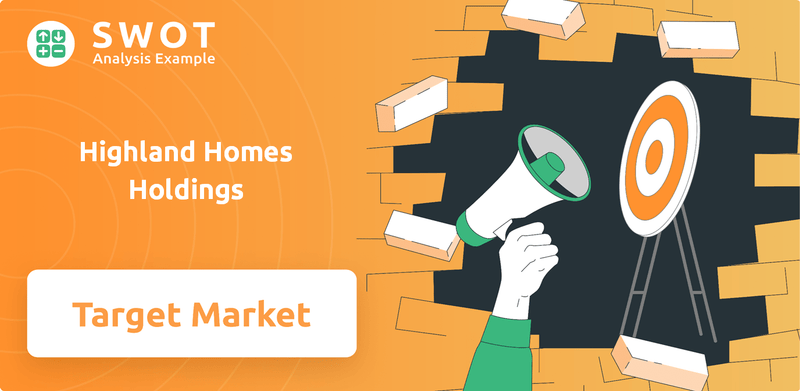
This exploration of Highland Homes' customer profile will uncover the demographic trends influencing their success. We'll analyze the age range and income level of their homebuyers, pinpointing the geographic location of their target market. This market analysis will reveal the ideal customer and how Highland Homes segments its market to meet their needs, ensuring the company remains a leader in the homebuilding industry.
Who Are Highland Homes Holdings’s Main Customers?
Understanding the customer demographics and target market for the company involves examining its product offerings and market focus. The company primarily caters to consumers (B2C) seeking single-family homes within master-planned communities. This approach suggests a diverse customer base, including middle-income families and affluent buyers, as homes range in price from the $310,000s to over $1 million, with semi-custom homes through Huntington Homes starting at $1.5 million.
The company's focus on master-planned communities indicates a target market that values community amenities and a structured living environment. These communities often attract families, empty nesters, and young professionals. The expansion into townhomes in Houston reflects an adaptation to evolving lifestyle preferences, aiming to serve a broader range of buyers beyond traditional single-family homes. In 2024, master-planned communities saw a 15% increase in sales, highlighting their continued popularity among the company's target segments.
The company's emphasis on personalization, with 65% of buyers utilizing personalization options in 2024, further points to customers who desire tailored homes. This reflects a customer base that values customization and seeks homes that meet their specific needs and preferences. The company's consistent growth, closing 3,876 homes in the past year, a 69% jump from 2015, demonstrates its ability to adapt to and capture market demand. For a deeper dive into the company's expansion and strategies, explore the Growth Strategy of Highland Homes Holdings.
The target market includes a range of income levels, from middle-income families to affluent buyers. This is evident in the pricing of homes, which spans from the $310,000s to over $1 million. Semi-custom homes through Huntington Homes cater to buyers with higher income levels, starting at $1.5 million.
The target age range is diverse, encompassing families, empty nesters, and young professionals. The focus on master-planned communities suggests an appeal to various life stages. The expansion into townhomes in Houston caters to those seeking low-maintenance living, potentially attracting a wider age spectrum.
The primary geographic focus is on master-planned communities. The company operates in various locations, including Dallas and Houston, with expansion plans. The choice of locations reflects market demand and opportunities for growth. The company's strategic expansion indicates a keen understanding of regional preferences.
Customers value community, amenities, and a structured living environment. They often seek personalization and tailored homes. The expansion into townhomes caters to those seeking low-maintenance living. The company's focus on master-planned communities aligns with these preferences.
The company's ideal customer values community, personalization, and a structured living environment. The target market includes a diverse range of buyers, from middle-income families to affluent individuals. The company's ability to adapt to market trends and customer preferences is key to its success.
- Values community and amenities.
- Seeks personalized home options.
- Prefers structured living environments.
- Ranges from middle-income to affluent buyers.
Highland Homes Holdings SWOT Analysis
- Complete SWOT Breakdown
- Fully Customizable
- Editable in Excel & Word
- Professional Formatting
- Investor-Ready Format
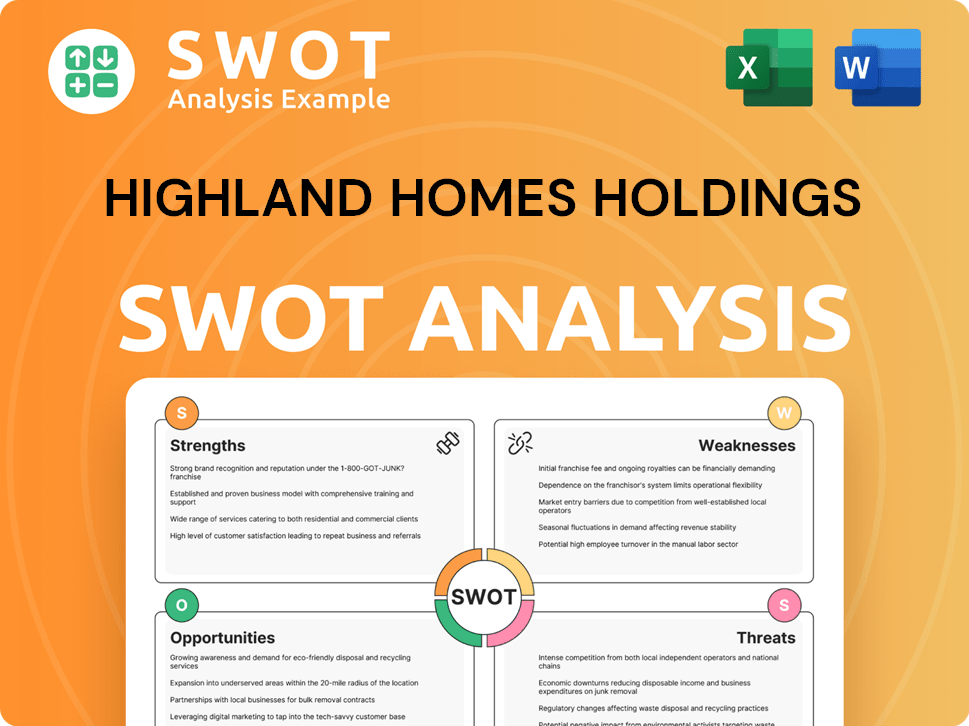
What Do Highland Homes Holdings’s Customers Want?
Understanding the customer needs and preferences is crucial for the success of any homebuilder. For Highland Homes Holdings, this involves a deep dive into what drives their homebuyers, focusing on quality, personalization, and community. This customer-centric approach is reflected in their offerings and marketing strategies.
The company's strategy is to meet the needs of their customers by offering various home designs and personalization options, with a focus on building homes that cater to individual tastes and family needs. Furthermore, they aim to create a sense of community and offer access to amenities, which is evident in their master-planned communities.
Highland Homes' focus on customer satisfaction and providing a seamless homebuying experience is a key factor in their success. They continuously evolve their offerings based on customer feedback and market trends, ensuring they meet the demands of modern living.
Homebuyers actively seek homes that offer diverse designs and customization options. In 2024, approximately 65% of buyers utilized personalization options at their Personal Selection Studio. This demonstrates a strong preference for tailoring living spaces to individual tastes.
The desire for a sense of community and access to amenities heavily influences purchasing decisions. Master-planned communities, featuring parks, trails, and pools, are a core part of their offerings. These communities cater to the psychological and aspirational needs of homebuyers.
Customers seek practical solutions for contemporary living, including energy-efficient construction techniques and flexible floor plans. They address common pain points by offering 'quick move-in homes' to bypass lengthy building delays. This responds to customer desires for efficiency.
Product development is heavily influenced by feedback and market trends. They conduct extensive lifestyle research and incorporate customer feedback to continuously evolve home designs. This approach ensures that homes promote modern living.
They adapt their offerings to specific market demands. For instance, the introduction of townhomes in the Houston market caters to a segment seeking a luxurious yet low-maintenance lifestyle within master-planned communities. This demonstrates flexibility and responsiveness to market needs.
The company emphasizes award-winning customer service and a positive homebuilding journey. They focus on clear communication and readily available support. Proactive measures, like 30-day post-close appointments, aim to build trust and differentiate them in a competitive market.
The commitment to understanding and meeting customer needs is a key aspect of the Marketing Strategy of Highland Homes Holdings. This customer-first approach, combined with data-driven product development and a focus on community, positions the company well in the competitive real estate market. Customer satisfaction scores are a crucial metric for homebuilders in 2024, highlighting the importance of these strategies.
Customer demographics of Highland Homes and their target market are driven by several key factors.
- Personalization: The ability to customize homes to individual tastes and needs.
- Community: A desire for homes within master-planned communities offering amenities and a sense of belonging.
- Efficiency: Solutions like 'quick move-in homes' to avoid delays.
- Modern Living: Homes designed with energy efficiency and flexible floor plans.
- Customer Service: Clear communication, readily available support, and a focus on a positive homebuilding experience.
Highland Homes Holdings PESTLE Analysis
- Covers All 6 PESTLE Categories
- No Research Needed – Save Hours of Work
- Built by Experts, Trusted by Consultants
- Instant Download, Ready to Use
- 100% Editable, Fully Customizable
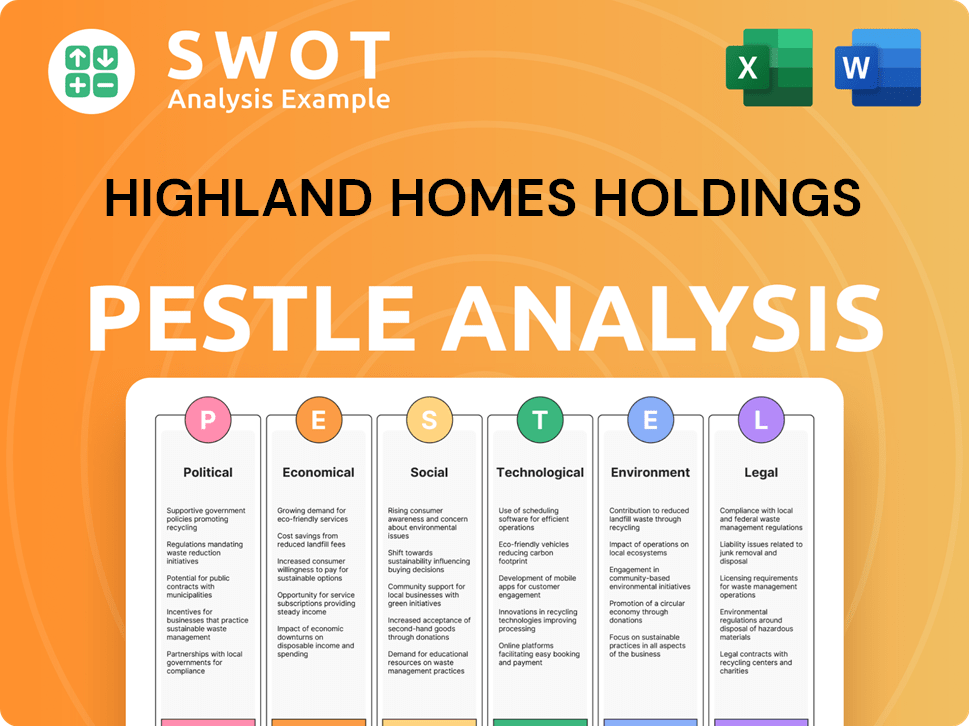
Where does Highland Homes Holdings operate?
The geographical market presence of Highland Homes Holdings is primarily concentrated in Texas and Florida, reflecting a strategic focus on high-growth areas. In Texas, the company's key markets include Dallas-Fort Worth, Houston, San Antonio, and Austin. Meanwhile, in Florida, Highland Homes operates in Central Florida, Tampa Bay, Lakeland-Winter Haven, Ocala, Orlando, and Bradenton-Sarasota, demonstrating a broad regional footprint.
This strategic distribution allows the company to capitalize on the diverse economic landscapes and housing demands within these states. For example, the Dallas-Fort Worth market saw over 40,000 new home sales in 2023, a 3.5% increase year-over-year, highlighting the region's strong growth. Similarly, Houston experienced a 3.5% increase in home sales in 2024, indicating robust market activity and potential for Highland Homes to capture market share. In Central Florida, approximately 40,000 new homes were sold in 2024, with Highland Homes selling over 1,500 homes, solidifying its position.
Highland Homes tailors its offerings to meet specific regional demands, as evidenced by its expansion into townhomes in Houston. This caters to the 'lock-and-leave' lifestyle preferred by certain demographics. Additionally, the company's venture into land development near Houston, specifically in Fulshear, aligns with areas experiencing significant population growth, such as a 50% increase from 2020 to 2023. This approach underscores the importance of understanding and responding to local market dynamics.
Highland Homes has spent decades understanding the Texas market, tailoring homes to meet local needs, and focusing on growth within the state. This long-term commitment allows the company to maintain a strong presence.
The top 10 builders increased their market share to 60% in 2024, intensifying competition. This highlights the importance of Highland Homes' established regional presence and localized strategies to maintain its market position. Learn more about the Competitors Landscape of Highland Homes Holdings.
Highland Homes Holdings Business Model Canvas
- Complete 9-Block Business Model Canvas
- Effortlessly Communicate Your Business Strategy
- Investor-Ready BMC Format
- 100% Editable and Customizable
- Clear and Structured Layout
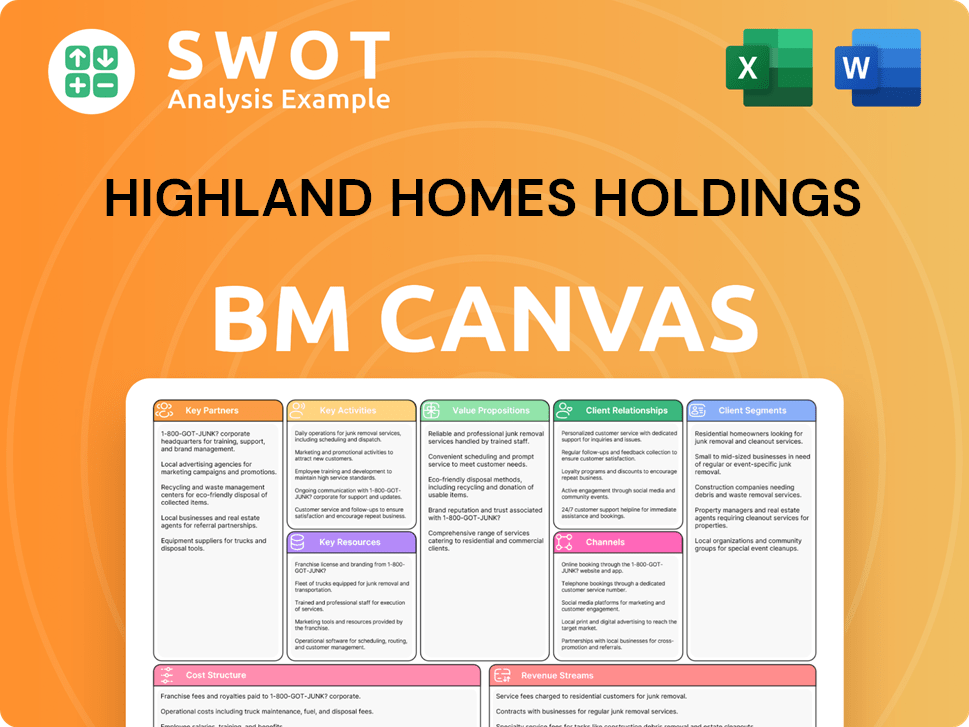
How Does Highland Homes Holdings Win & Keep Customers?
Customer acquisition and retention strategies are crucial for the success of any homebuilding company. For [Company Name], a multi-faceted approach is employed, focusing on attracting new customers and building lasting relationships. This involves a blend of marketing, sales tactics, and a strong emphasis on delivering a positive customer experience.
Marketing efforts include traditional channels like billboards and digital platforms, supplemented by sales incentives. Public relations and awards also play a significant role, with accolades prominently featured to build trust. The company's sales tactics include diverse home designs and personalization options, catering to various buyer preferences. Community living with amenities is also emphasized to boost buyer appeal and sales.
Retention strategies are deeply rooted in the customer experience. Clear communication, readily available support, and personalized service are prioritized to build trust. This customer-centric approach is pivotal, with customer satisfaction scores being a key metric. A notable initiative is a 30-day post-close appointment to proactively address any customer questions or issues, ensuring goals are met.
Traditional media, such as billboards, and digital platforms, are used to reach potential homebuyers. Sales incentives are also offered to attract new customers. In 2024, digital marketing spend in the real estate sector increased by approximately 12%.
Offering diverse home designs and personalization options is a key strategy. Quick move-in homes are also available to meet immediate needs. The demand for move-in-ready homes increased by 8% in the first quarter of 2024.
Clear communication and readily available support are emphasized. Personalized service and transparency build trust and differentiate the company in a competitive market. Customer satisfaction scores are a key performance indicator (KPI).
The 30-day post-close appointment is a proactive measure to address customer questions. This initiative helps ensure customer satisfaction and identifies any potential issues early on. Proactive follow-ups can increase customer retention rates by up to 10%.
Customer data and segmentation are crucial for targeted campaigns. While specific details on CRM systems are not publicly disclosed, the industry widely utilizes CRM to organize customer data, including demographics, purchase history, and interaction records, to create targeted and personalized campaigns. This allows businesses to segment customers (e.g., first-time buyers, repeat customers) and tailor offers, improving engagement and conversion rates. The company's consistent high rankings by J.D. Power and Associates and numerous 'People's Choice Builder of the Year' awards reflect their successful customer-centric approach. The shift to employee ownership in 2015 was aimed at maintaining a customer-focused culture, impacting customer loyalty and repeat business. The fact that many customers are repeat buyers, with some even being generational buyers, demonstrates strong customer loyalty and retention. Customer retention in the homebuilding industry is critical, with repeat customers often accounting for a significant portion of sales; data from 2024 shows that repeat buyers contribute to approximately 25% of overall sales for leading builders.
Utilizes a mix of traditional and digital marketing to reach potential homebuyers. Awards and positive press are highlighted to build trust. In 2024, companies that prominently featured awards saw a 10% increase in consumer interest.
Offers diverse home designs and personalization options. Focuses on community living with amenities to attract buyers. Personalization options can increase sales conversion rates by up to 15%.
Prioritizes clear communication, readily available support, and personalized service. The 30-day post-close appointment demonstrates a commitment to customer satisfaction. Proactive customer service can increase customer satisfaction scores by up to 20%.
Employs CRM systems to organize customer data for targeted campaigns. Customer segmentation allows for tailored offers, improving engagement. Data-driven marketing can increase conversion rates by up to 30%.
The shift to employee ownership in 2015 aimed to maintain a customer-focused culture. This change has likely contributed to higher customer loyalty and repeat business. Employee-owned companies often experience higher customer satisfaction levels.
The presence of repeat and generational buyers indicates strong customer loyalty. One customer has closed on their fifth home, highlighting exceptional retention. Repeat customers often generate a higher lifetime value for the company.
Highland Homes Holdings Porter's Five Forces Analysis
- Covers All 5 Competitive Forces in Detail
- Structured for Consultants, Students, and Founders
- 100% Editable in Microsoft Word & Excel
- Instant Digital Download – Use Immediately
- Compatible with Mac & PC – Fully Unlocked
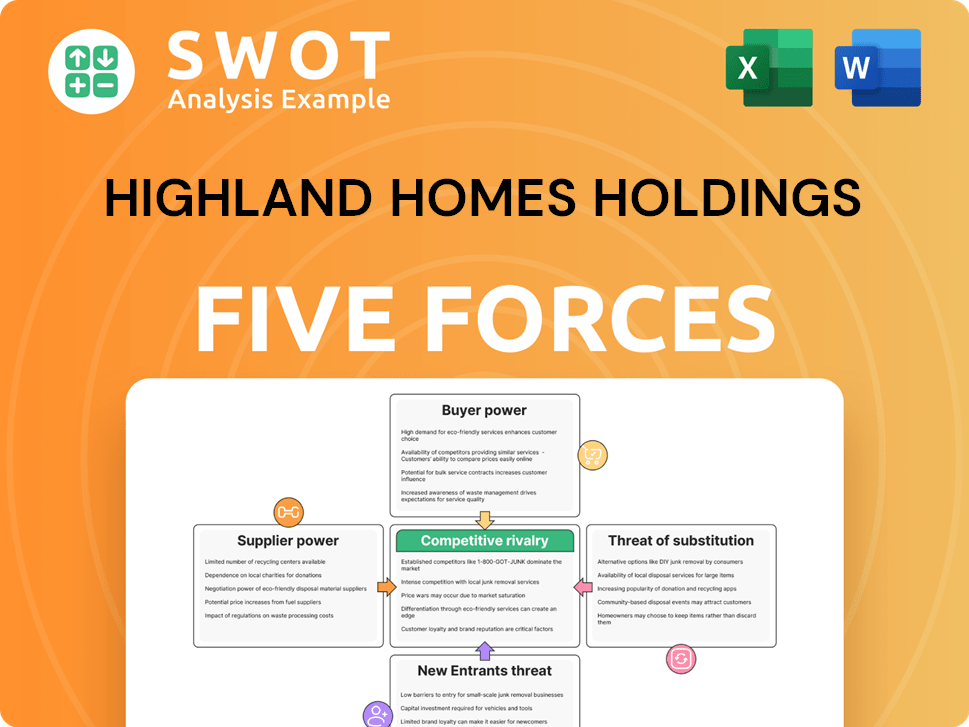
Related Blogs
- What are Mission Vision & Core Values of Highland Homes Holdings Company?
- What is Competitive Landscape of Highland Homes Holdings Company?
- What is Growth Strategy and Future Prospects of Highland Homes Holdings Company?
- How Does Highland Homes Holdings Company Work?
- What is Sales and Marketing Strategy of Highland Homes Holdings Company?
- What is Brief History of Highland Homes Holdings Company?
- Who Owns Highland Homes Holdings Company?
Disclaimer
All information, articles, and product details provided on this website are for general informational and educational purposes only. We do not claim any ownership over, nor do we intend to infringe upon, any trademarks, copyrights, logos, brand names, or other intellectual property mentioned or depicted on this site. Such intellectual property remains the property of its respective owners, and any references here are made solely for identification or informational purposes, without implying any affiliation, endorsement, or partnership.
We make no representations or warranties, express or implied, regarding the accuracy, completeness, or suitability of any content or products presented. Nothing on this website should be construed as legal, tax, investment, financial, medical, or other professional advice. In addition, no part of this site—including articles or product references—constitutes a solicitation, recommendation, endorsement, advertisement, or offer to buy or sell any securities, franchises, or other financial instruments, particularly in jurisdictions where such activity would be unlawful.
All content is of a general nature and may not address the specific circumstances of any individual or entity. It is not a substitute for professional advice or services. Any actions you take based on the information provided here are strictly at your own risk. You accept full responsibility for any decisions or outcomes arising from your use of this website and agree to release us from any liability in connection with your use of, or reliance upon, the content or products found herein.